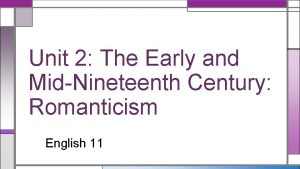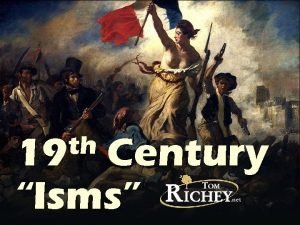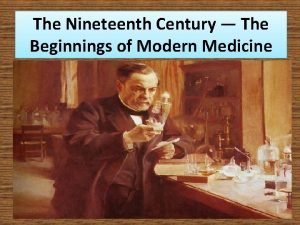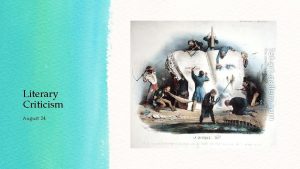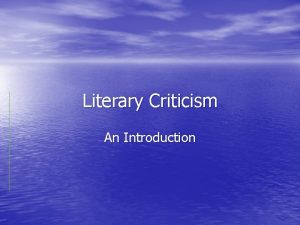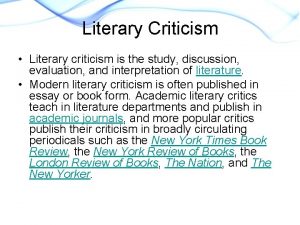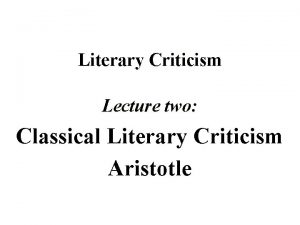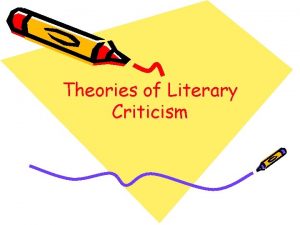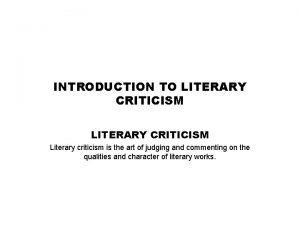LITERARY CRITICISM 2017 2018 The Later Nineteenth Century











- Slides: 11

LITERARY CRITICISM 2017 -2018

The Later Nineteenth Century: Victorian Criticism Ú CULTURAL CRISIS Ú - Queen Victorian 1837 -1901 Ú - Various changes Ú - Growth of evolutionary and biological science Ú - Faith in old ideals was shaken Ú - Industrial Revolution

CULTURAL CRISIS Ú - Class tensions Ú - passion for disciplinary Ú - philosophy of Saint Simon and August Comte (realism and Factness) Ú - Rationalistic and Materialistic VS. Ú The romantic -idealistic

Stages of Victorian Criticism Ú 1. the early Victorian(1835 -1860) Ú 2. the middle stage(1860 -1880) Ú 3. the later stage( 1880 -1900)

Critics’ aim Ú Literary criticism to be worthwhile must serve the ends of life and promote a better understanding of cultural values and thus bring about social regeneration. Poetry must be, ‘Criticism of Life’ Ú To make life nobler and better

Arnold, Matthew Ú - “The Function of Criticism at the Present Time” Ú - “Study of Poetry”

COMING LECTURE Ú The Twentieth Century: Modernism, Ú T. S. Eliot,

The Twentieth Century: Modernism Ú - The radical shift in aesthetic and cultural sensibilities evident in the art and literature of the early twentieth century (especially post war world One). Ú - A distinctive break with Victorian morality. Ú - The modernist authors presented a pessimistic picture. .

Modernism Ú Occurred during the post ww 1 era. Ú Rejected Optimism in the 19 th c. and took a pessimistic stance on world issues and events. Ú The new must replaced the old. Ú Reexamine everything.

What led to modernism? Ú 1. development of industrial societies. Ú 2. rapid growth in cities. Ú 3. the horrors of 2 world wars. Ú 4. gender, class and race struggles shaped the trend. Ú 5. loss of faith in God, governments and human goodness. Ú 6. impact on individual and Western society.

Characteristics of modernism includes: Ú Disruption of linear flow of narrative Ú Frustration with expectations concerning unity Ú Ú and coherence Language is central to artistic exploration. Focus on the individual and his alienation and confusion. Interest in rhythm and everyday language. Heavy use of symbolism and setting.
 Post test the early and mid nineteenth century romanticism
Post test the early and mid nineteenth century romanticism Horace taylor, the verdict, september 25, 1899
Horace taylor, the verdict, september 25, 1899 Nineteenth century isms review
Nineteenth century isms review Chapter 4 notes fiber evidence
Chapter 4 notes fiber evidence Nineteenth century
Nineteenth century Formalism vs structuralism
Formalism vs structuralism Descriptive criticism vs prescriptive criticism
Descriptive criticism vs prescriptive criticism Biblical criticism is not a form of historical criticism
Biblical criticism is not a form of historical criticism What is constructive criticism
What is constructive criticism Hyperpoetry examples
Hyperpoetry examples Matura 2018/19
Matura 2018/19 Tsds peims 2017 2018
Tsds peims 2017 2018
